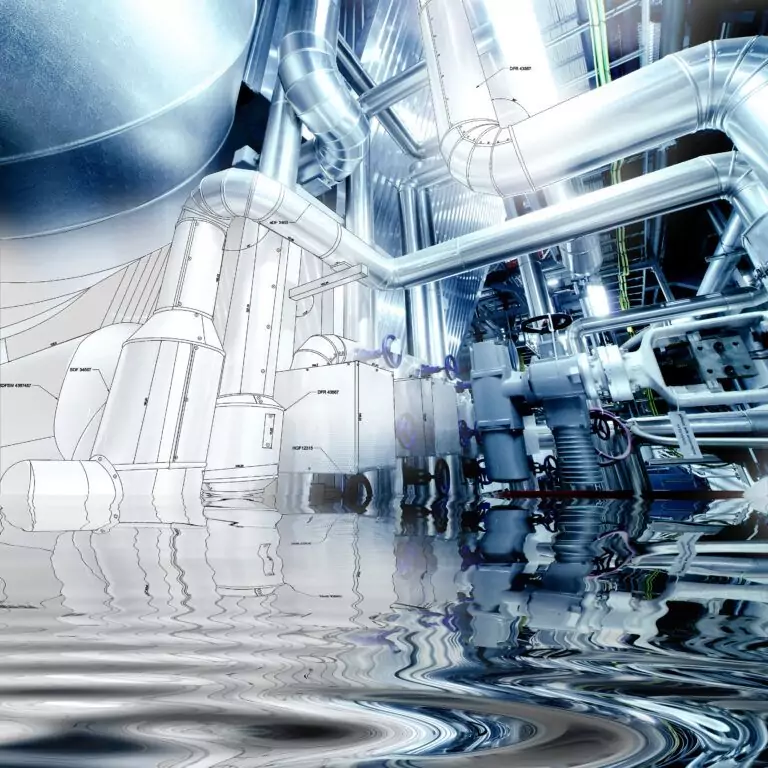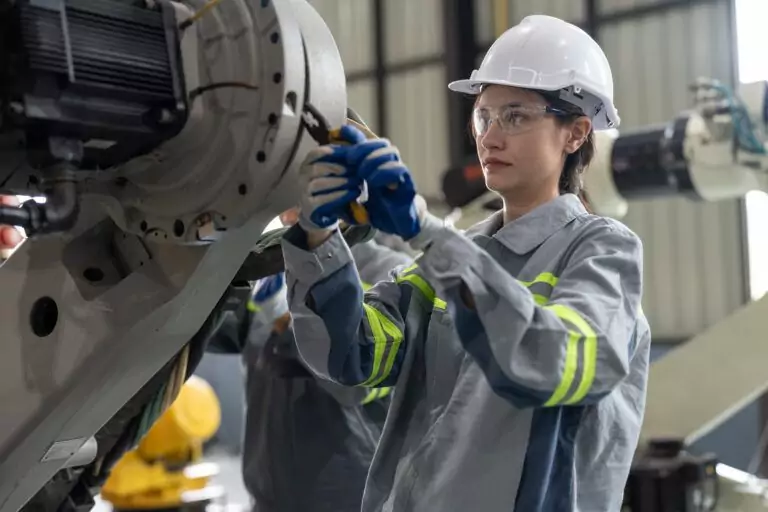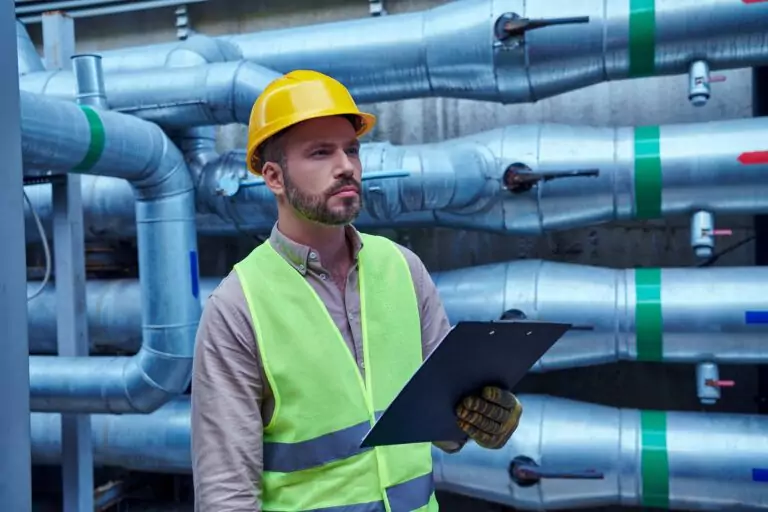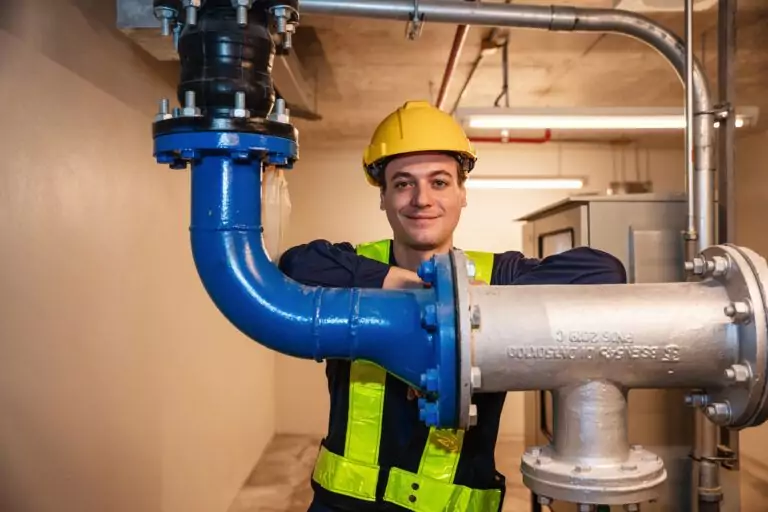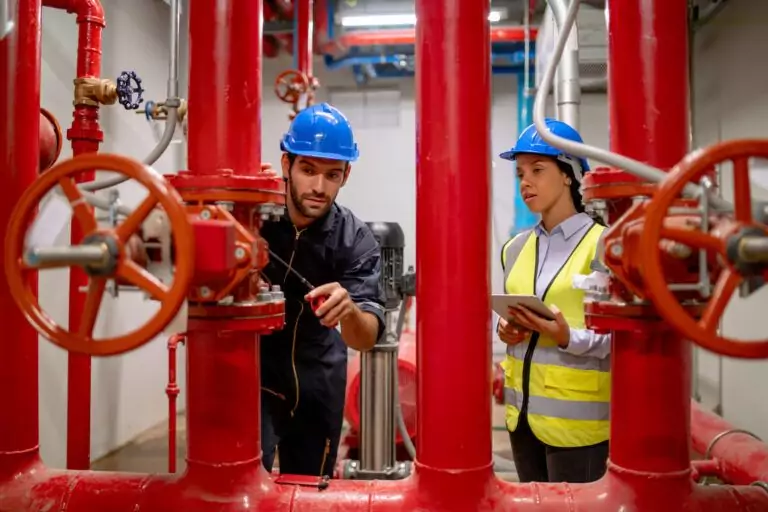Multi-disciplinary coordination failures cause most mechanical engineering project delays, far exceeding purely technical challenges.
Your engineering degree taught you thermodynamics, mechanics of materials, and heat transfer equations. Then you started your first industrial project and discovered the real challenge isn’t calculating stress distributions in structural beams. It’s getting the electrical discipline engineer to provide motor specifications before you finalise equipment foundation loads. It’s redesigning a pump skid three times because process flow requirements keep evolving. It’s explaining to a construction superintendent why that pipe support location actually matters for thermal expansion management.
Industrial mechanical engineering involves obstacles that textbooks never mention. You’re coordinating with five other engineering disciplines: process, electrical, instrumentation and controls, civil/structural, and piping. All of them need critical information yesterday. Clients change specifications after you’ve issued drawings for fabrication. Equipment vendors deliver certified drawings weeks late. Field conditions contradict your 3D plant models. Code reviewers reject calculations that worked on your last three projects.
This guide addresses real-world challenges across capital project lifecycles. You’ll find practical frameworks for coordinating multi-disciplinary work, managing scope changes, navigating conflicting standards, and designing equipment that construction contractors can actually build.
Disclaimer: Engineering challenges vary significantly by industry sector, project type, organisational structure, and geographic region. All cost references, timeframes, and performance metrics are approximate and subject to substantial variation based on local conditions, market factors, and specific project circumstances. Always verify current information with qualified professionals, local authorities, and applicable standards for your specific situation. Adapt all recommendations to your circumstances and verify against your organisation’s standards.
Handling Multi-Disciplinary Coordination Without Becoming a Bottleneck
Most engineering problems aren’t actually technical challenges requiring advanced calculations. They’re coordination failures between disciplines that should work together. Experienced project managers recognise this reality: coordination issues between disciplines drive most schedule delays in multi-discipline projects. Internal project tracking consistently shows interface problems creating more delays than calculation errors or design challenges.
Understanding Mechanical-Electrical Interface Conflicts
You’ve spent three weeks perfecting compressor package specifications, assuming a 480V power supply based on initial electrical distribution plans. The electrical engineer walks into the coordination meeting and announces they’re providing 4160V based on voltage drop calculations. Your carefully developed equipment specs just became obsolete. Now you’re revising motor specifications, renegotiating vendor quotes, and redesigning motor control centres.
This happens because mechanical equipment designers and electrical power systems engineers work on parallel tracks without sufficient communication touchpoints. Monthly integration meetings reveal fundamental conflicts. Post-project reviews consistently identify multiple major mechanical-electrical interface problems requiring significant rework in most complex projects.
Process-Mechanical Integration Challenges
Process-mechanical integration creates even longer-lasting impacts on project economics. Process engineers develop required pump flow rates based on heat and material balance calculations using simulation software like Aspen HYSYS or UniSim Design. You select centrifugal pumps using those process parameters as your design basis. Then, process simulation models get refined during detailed engineering as more accurate property data becomes available. Volumetric flow rates increase substantially due to updated density calculations. Your previously selected pumps no longer operate at the revised flow conditions.
Either you oversize all rotating equipment initially as contingency, which increases capital costs unnecessarily, or accept that you’ll revise equipment selections during detailed engineering. Project experience across oil and gas, petrochemical, and power sectors shows that major process parameter changes occur frequently during the transition from FEED to detailed engineering.
Civil-Mechanical Foundation Coordination Problems
Civil-mechanical foundation design frustrates all parties and creates circular dependency problems. You need the civil/structural engineering discipline to design equipment foundations, concrete piers, and structural steel platforms. They need accurate equipment weights, centre of gravity locations, operating loads, seismic loads, and thermal growth characteristics from your mechanical design. You can’t finalise equipment specifications until you know foundation elevations, available plot space, and structural capacity limitations. Classic chicken-and-egg coordination problem.
Instrumentation and controls integration adds another complex coordination layer. Your mechanical equipment packages need temperature transmitters, pressure transmitters, flow meters, level switches, and control valves. I&C discipline engineers need mounting locations, process connection sizes, electrical area classifications, and instrument specification sheets from your mechanical design. You need instrument technical specifications to verify they’ll survive process conditions: temperature ranges, pressure ratings, corrosive environments, and vibration levels.
Managing Documentation and Version Control Failures
Documentation handoffs break down predictably when version control fails. You issue equipment data sheets to the piping discipline team for 3D layout development. They import your equipment data into their plant design software and start the piping routing process. You revise equipment data sheets based on vendor feedback that changes nozzle sizes, orientations, and equipment footprint dimensions. The piping design team doesn’t see the revision notification. They continue working with outdated equipment information for weeks.
Version control becomes impossible when multiple engineering disciplines reference shared 3D equipment models without synchronised model management. Your mechanical equipment 3D model shows four nozzle connections on a pressure vessel: inlet, outlet, vent, and drain. The piping discipline references that equipment model and starts detailed pipe stress analysis. You add a fifth nozzle connection based on updated process requirements. The piping team’s model still shows four connections because model synchronisation doesn’t happen automatically.
Communication barriers between discipline specialists slow information flow. Electrical engineers speak in technical language about voltage drops, protective relay coordination, and short circuit calculations. Process engineers discuss theoretical stages, separation efficiency, and mass transfer coefficients. Civil/structural engineers focus on soil bearing capacity, seismic design categories, and foundation settlement. You’re trying to design mechanical equipment packages that satisfy all their interdisciplinary requirements simultaneously.
Organisations emphasising integrated engineeringThe process of integrated engineering involves multiple engineering disciplines working in conjunction with other project disciplines to e... address these coordination challenges structurally. When mechanical equipment designers, process simulation engineers, electrical power systems specialists, civil/structural engineers, and I&C instrumentation experts work as genuinely collaborative teams, most interface issues get identified and resolved during design development phases. This connected approach forms the foundation of how firms like Vista Projects execute complex industrial projects.
Balancing Design Quality Against Aggressive Project Schedule Pressures
You want to deliver excellent engineering work: thorough analysis, comprehensive documentation, and peer-reviewed calculations that exceed code minimums. Clients want deliverables yesterday to meet construction start dates and project financing milestones. Managing this perpetual tension between quality and speed determines whether you build a sustainable engineering career or burn out.
When to Use Engineering Judgment vs. Detailed Analysis
Engineering judgment means knowing when to stop analysing and move forward with design decisions. You could theoretically run finite element analysis using ANSYS, ABAQUS, or SolidWorks Simulation on every pipe support bracket and equipment mounting pad. Or you could use standard structural steel sections selected from AISC load tables, apply conservative safety factors, and move forward.
FEA for critical applications makes complete sense: high-pressure piping systems, pressure vessel nozzle reinforcements, seismic-qualified equipment supports, fatigue-sensitive connections. FEA for routine supports consumes hours per analysis that could be spent on more valuable design activities. Risk-based approaches to design verification help prioritise engineering effort where it matters most.
Documentation standards that satisfy requirements without over-engineering deliverables save weeks per project phase. Some clients need comprehensive calculation packages that explain every assumption and show every intermediate step. Other clients want results-oriented deliverables: key inputs stated, calculation methodology referenced, results with acceptance criteria, and conclusions with recommendations.
Handling Client Scope Changes During Design
Client requirement changes after design phases reach substantial completion destroy schedules, waste engineering effort, and create abortive work charges. Project experience shows that most industrial capital projects experience at least one major scope change after preliminary engineering approval.
Here’s the typical cascading impact: You finish equipment specifications for all rotating equipment. Issue requisitions to vendors for quotes. Start foundation design based on preliminary equipment data. The client decides they want substantially higher throughput capacity to capture additional market opportunities. Back to square one on equipment sizing calculations. Vendor information delays force design assumptions you’ll inevitably regret later.
Communicating Technical Risks Under Schedule Pressure
Communicating technical risks when schedules compress requires professional courage and clear documentation. The project manager says to finish the mechanical detailed design in half the originally planned time to meet an accelerated construction start date. You can theoretically hit that compressed schedule by skipping pipe stress analysis on critical high-pressure hydrocarbon piping systems, using undersized safety factors on pressure vessel calculations, and eliminating peer review quality checks.
Tell the project manager explicitly what you’re sacrificing to hit the impossible schedule. Explain the actual risks in business language they understand: potential for catastrophic piping failure causing production outages, regulatory violations resulting in facility shutdown orders, and liability exposure if the incident investigation reveals inadequate engineering. Document your concerns in an email to project leadership.
Building buffer and contingency into schedule estimates creates realistic project planning. If mechanical equipment design typically takes a certain duration under normal conditions, estimate with a significant additional buffer in your project schedule. You’ll need that contingency when vendor technical data arrives late, client changes specifications mid-design, or peer review identifies issues requiring revision.
Overcoming Code Compliance and Regulatory Obstacles
Standards, codes, and regulations exist for legitimate safety reasons. They’re written in blood based on past failures that killed people, destroyed equipment, or caused environmental disasters. That doesn’t make them any less frustrating when you’re trying to deliver a project across multiple jurisdictions with conflicting requirements.
Regulatory Disclaimer: Code requirements and regulations change frequently and vary significantly by jurisdiction. Always verify current requirements with local authorities having jurisdiction and consult with licensed professionals for your specific application.
Working With Conflicting ASME, API, and International Standards
ASME pressure vessel codes, API equipment standards, and local jurisdiction requirements contradict each other frequently in international projects and even in some domestic work. ASME Section VIII Division 1 specifies one approach to pressure vessel design using design-by-rule methodology. Client engineering specifications require API standards for storage tanks. Local building jurisdiction enforces IBC and ASCE 7 seismic requirements that conflict with both ASME and API approaches.
You’re responsible for reconciling these differences, determining which code takes precedence based on contract language and regulatory authority, and documenting your reconciliation approach in design basis documents. Client specifications that exceed code minimum requirements add cost and engineering complications.
International project compliance across different regulatory frameworks multiplies the challenge exponentially. Pressure vessel design for a Canadian project follows CSA standards. Similar equipment for a Middle Eastern project uses European EN standards. Chinese projects reference GB codes. Australian projects follow AS standards.
Creating Documentation That Satisfies Code Reviewers
Calculation packages that satisfy code requirements and reviewer expectations need much more than mathematically correct results. Code reviewers and authorities having jurisdiction want clear documentation of design basis, material selection justification, load case definitions, and acceptance criteria. Presenting calculation results without showing your methodology, assumptions, and code section references guarantees rejection notices and resubmission cycles that add weeks to approval timelines.
Material traceability and certification documentation seem like bureaucratic paperwork until regulatory inspectors reject your pressure equipment during shop fabrication or field inspection. Every piece of pressure-retaining material needs mill test reports proving that chemical composition and mechanical properties meet specifications.
Design basis documentation for future reference and modifications protects everyone. When someone modifies your equipment design years later, they need to understand your original design assumptions, constraints, material selection rationale, and analysis methodology.
Addressing Knowledge Gaps as Technology Evolves
Engineering fundamentals don’t change significantly. Tools, technologies, industry practices, and software platforms evolve constantly. Keeping up without falling behind in your current project work creates perpetual tension.
Transitioning from 2D CAD to 3D Plant Design Tools
Learning new software platforms while maintaining productivity means you’re temporarily less efficient during the learning curve. Moving from 2D CAD systems to 3D plant design tools requires substantial training investment: formal training hours plus extended on-the-job learning before you achieve equivalent productivity to your previous 2D workflow. Your productive output drops substantially for several months during this learning curve.
Moving from 2D drafting to 3D design environments mid-career disrupts established workflows developed over decades of professional practice. Industry standard practice is now 3D plant design with integrated models, automatic clash detection, and schedule simulation. Learning new software feels like starting your engineering career over when you should be hitting peak productivity.
Learning Emerging Technologies in Carbon Capture and Hydrogen
Understanding emerging technologies relevant to your industry sector takes time while managing demanding work weeks. Carbon capture and storage systems require new approaches to compressor design, heat exchanger specification, and material selection. Hydrogen production facilities demand different material selection criteria to prevent hydrogen embrittlement. Renewable energy integration creates mechanical engineering challenges that didn’t exist a decade ago.
Balancing specialisation depth with broad engineering knowledge affects long-term career paths and marketability. Deep expertise in rotating equipment makes you extremely valuable for major projects requiring that specific knowledge. Narrow specialisation limits opportunities: if markets decline regionally, your specialised knowledge has limited transferability to other industry sectors.
Adopting Digital Asset Management Systems
Managing engineering data in digital asset managementDigital asset management (DAM) is a business process to organize, store, and process digital information related to real-world assets. In th... systems rather than traditional file folder structures requires fundamentally different thinking. Asset information management systems like AVEVA Asset Information Management, IBM Maximo, or Bentley AssetWise tag data by equipment ID, document type, and project phase, using relational database structures. A different paradigm that takes training plus months of practice to become proficient. The payoff includes drastically improved data findability, better version control, automated workflow routing, and complete asset lifecycle visibility.
Applying theoretical knowledge to practical equipment design reveals gaps in engineering education. University thermodynamics courses taught you heat transfer equations and log-mean temperature difference calculations. Industrial projects require selecting specific heat exchanger types based on fouling characteristics, maintenance access requirements, plot space constraints, utility availability, and capital cost targets.
Managing Vendor Relationships and Equipment Integration
Equipment vendors are simultaneously valuable technical partners and potential project obstacles, depending on how you manage relationships. Vendors possess deep application expertise. They also have sales quotas, manufacturing capacity constraints, and profit margins to protect.
Pricing Disclaimer: All cost and schedule references are approximate and vary significantly by region, project scale, market conditions, equipment type, and timing. Verify current pricing and lead times with vendors for your specific application.
Coordinating Equipment Specifications Across Multiple Vendors
Interface requirements spanning multiple vendor packages create coordination confusion. The Compressor package supplier provides foundation loads, utility requirements, and dimensions. The driver manufacturer provides motor specifications and coupling requirements. Coupling vendor needs precise shaft dimensions from both suppliers. Getting three vendors to coordinate interface details requires constant attention through detailed interface requirement documents, regular technical coordination calls, and formal approval protocols.
Performance guarantees get contentious when system performance doesn’t meet expectations, and vendors blame each other. Pump vendor guarantees specifications. The system doesn’t perform. Vendor blames piping pressure drop. Piping design meets standards. Nobody wants to pay for modifications. You’re mediating technical disputes and performing forensic analysis to determine the root cause.
Extracting Usable Engineering Data from Vendor Drawings
Incomplete vendor drawings delay downstream discipline work. The vendor provides major dimensions. Piping needs exact nozzle locations for 3D layout. The vendor says detailed drawings come months after the purchase order. You need information now. Most equipment packages initially provide insufficient detail, requiring follow-ups, assumptions, or delays.
Conflicting vendor documents create confusion. The Data sheet shows one weight. The foundation drawing shows different weights. Dimensions don’t match between documents. The vendor takes weeks to clarify. Timing delays when vendor data arrives significantly after you need it create critical path problems.
Integrating Packaged Equipment Into Plant Design
Utility requirements that significantly exceed initial vendor estimates force utility system redesign. The vendor budgetary proposal indicates certain cooling water, instrument air, and electrical power needs. After detailed engineering, updated requirements show substantially higher consumption. Your utility systems, designed to the original estimates, are now undersized.
Space constraints when actual equipment dimensions differ from preliminary data force plot layout revisions. The vendor budgetary proposal shows specific footprint and height. Detailed design shows larger dimensions due to additional components and vendor-preferred orientation. The equipment no longer fits in the allocated space.
Maintenance access requirements that vendors overlook create operational problems. The equipment works fine until maintenance needs to remove components. Physical removal requires overhead clearance for lifting. Your plant layout shows structures blocking required lifting paths.
Documentation trails for decisions affecting equipment performance protect everyone. Vendor proposes material substitution. You review properties and approve based on analysis. The equipment experiences premature failure. Without a documented approval trail showing your technical analysis and rationale, finger-pointing begins.
Handling Constructability Issues and Field Reality
Engineering designs that look geometrically perfect in 3D plant models sometimes fail when confronted with field construction reality. Understanding construction challenges early prevents expensive field problems when modification costs are significantly higher.
Designing for Construction Installation Sequences
Equipment installation sequences that look feasible in 3D models fail in practice and create construction delays. Your 3D model shows that a large pressure vessel fits through the access door with adequate clearance. The construction rigging team explains they can’t physically rotate the vessel from horizontal transport orientation to vertical installation position due to crane boom geometry, lifting point locations, and rigging equipment space requirements.
Experience shows that constructability reviews performed by experienced construction personnel during detailed engineering prevent a significant portion of field installation problems. Organisations skipping formal constructability reviews experience substantially higher rates of field design changes and construction rework.
Access limitations during construction and maintenance operations get overlooked. The equipment works perfectly during normal operation. Maintenance procedures require replacing internal components periodically. Physical disassembly requires removing the vessel head and lifting out the internal assembly. Overhead structures block required crane access.
Resolving Field Issues and Design Modifications
Design modifications when field conditions differ from drawings happen on virtually every industrial construction project. Foundation elevation as-built measures differently than design drawings show due to formwork settlement, concrete shrinkage, or surveying errors. Connected piping requires a complete revision. You’re issuing field change notices while simultaneously trying to finish detailed engineering work on the next project phase.
Vendor data corrections discovered during delivery create crises. Compressor package arrives. The installation contractor discovers that the nozzle orientation differs from the approved certified drawings used for piping fabrication. Piping is already fabricated. Now you’re performing emergency analysis to determine solutions.
Coordination issues that only become apparent during construction reveal gaps in 3D modelling and clash detection. Electrical conduit runs conflict with pipe support and structural steel. Platform beam blocks required valve access. Your 3D model clash detection didn’t catch these conflicts.
Creating Accurate As-Built Documentation
Capturing field changes in final as-built documentation requires discipline when project budget pressure is highest and team members are transitioning to new projects. Construction made hundreds of modifications to resolve field interferences and accommodate actual site conditions. You need to incorporate all those changes into as-built drawings, updated 3D models, revised calculations, and final equipment data sheets.
Creating maintainable records for owner-operators serves clients far beyond project completion. Operating industrial plants need accurate as-built documentation for decades-long operational lifetimes. Your as-built drawings, 3D models, equipment data sheets, and material specifications become the foundation for future modifications, maintenance procedures, spare parts procurement, and troubleshooting.
Construction contractors challenge engineering decisions because experienced field construction professionals understand field realities, practical installation constraints, and labour productivity factors that office-based engineers rarely see directly.
Balancing Environmental Sustainability With Economic Realities
Everyone supports environmental responsibility, carbon footprint reduction, and sustainable engineering practices until they see the price tag and impact on project ROI. Managing this tension defines modern mechanical engineering practice in industrial sectors increasingly focused on ESG performance.
Evaluating Energy Efficiency Investment Payback Periods
Energy efficiency improvements that owners approve need demonstrable positive economics with acceptable payback periods. High-efficiency motors meeting NEMA Premium or IE3 efficiency standards cost substantially more than standard motors while reducing electrical energy consumption, depending on load profile and operating hours. Owner approval depends on meeting their investment criteria.
Understanding project economics and owner investment criteria helps target sustainability investments that make business sense. Industrial projects typically approve more energy efficiency proposals with shorter payback periods and fewer proposals with longer paybacks.
Implementing Carbon Capture and Zero Liquid Discharge Systems
Carbon capture and storage integration in existing facilities multiplies costs and complexity compared to greenfield installations. Retrofitting CO2 capture systems onto operating plants requires extensive plot space that doesn’t exist in brownfield sites, utility capacity that isn’t available without major expansions, and process integration disrupting operations.
Waste minimisation and zero liquid discharge requirements create additional engineering challenges beyond basic compliance. ZLD systems required in water-stressed regions require sophisticated multi-stage treatment: lime softening, reverse osmosis, evaporators, crystallizers, and solid waste handling.
Presenting Lifecycle Cost Analysis to Stakeholders
Lifecycle cost analysis, when sustainable options have higher initial capital costs, requires convincing stakeholders focused primarily on first-cost metrics. Stainless steel piping lasts decades in corrosive service with minimal maintenance. It costs substantially more initially than carbon steel with protective coatings. Lower maintenance costs over a long operational life can justify the capital investment with better lifecycle economics.
Quantifying long-term savings from sustainability investments requires rigorous analysis beyond simple first-cost comparison. Document energy savings with realistic operating hour assumptions. Calculate water cost savings, including future rate increases. Show maintenance cost reductions from corrosion-resistant materials and more efficient equipment.
Regulatory risk mitigation as an economic justification resonates with business leaders concerned about compliance costs and operational continuity. Environmental regulations consistently tighten over time. Investing in better environmental performance now avoids costly retrofits later.
Developing Your Engineering Career While Delivering Projects
Building long-term career success and professional growth while meeting immediate project demands creates constant tension between present performance and future development. Managing both simultaneously requires deliberate strategy, time management discipline, and realistic self-assessment of career goals.
Understanding which mechanical engineering skills industrial employers value most highly helps you prioritise professional development investments that accelerate career progression beyond pure technical depth.
Finding Mentorship for Mechanical Engineering Career Growth
Learning from senior mechanical engineers with specialised technical experience accelerates skill development far faster than independent learning through trial and error. Experienced engineers have encountered problems you’re facing for the first time. They know intuitively which design details matter critically and which have minimal impact.
Finding someone willing to share that accumulated knowledge through regular technical discussions, design review mentoring, and project guidance improves your engineering judgment years faster than learning entirely through your own experience and mistakes.
Cross-disciplinary mentorship that broadens perspective helps you become a more effective mechanical engineer. Understanding how process engineers approach equipment performance requirements helps you design better mechanical systems. Learning structural engineering principles helps you specify realistic mechanical equipment loads.
Choosing Between Technical Specialist and Management Paths
Industry sector knowledge versus transferable mechanical engineering skills affects long-term job security across economic cycles. Becoming a recognised expert in petrochemical rotating equipment provides deep specialisation that commands premium compensation. If petrochemical markets decline regionally, your highly specialised knowledge has limited value in other industry sectors.
Discipline depth versus project management breadth represents a fundamental career choice most mechanical engineers face mid-career. The pure technical specialist path develops deep engineering expertise, maintains hands-on design and analysis work, and builds a reputation as the technical expert. The project management and leadership path requires broader skills, including project scheduling, cost control, client relationship management, staff supervision, and business development.
Both paths offer rewarding careers with good compensation potential. Understand which path aligns better with your strengths, interests, and professional satisfaction drivers.
Staying informed about current mechanical engineering job market trends and employment outlook across different industry sectors helps you make strategic decisions about specialization depth versus breadth as markets evolve.
Navigating International Engineering Career Opportunities
Career advancement opportunities across different geographic locations affect family decisions and long-term career trajectory. Accepting international assignments for several years builds substantial project experience, exposes you to different engineering practices, develops cultural adaptability, and often accelerates career progression.
Cultural considerations in international environments extend beyond pure technical work. Business practices, communication styles, decision-making processes, client relationship expectations, and team dynamics vary substantially across global regions.
Building Resilience When Engineering Challenges Compound
These challenges rarely arrive individually. Real project experience means you’re simultaneously coordinating multiple disciplines, managing scope changes, learning new software, dealing with vendor delays, responding to field issues, and meeting aggressive deadlines.
Developing Systematic Processes Instead of Firefighting
Successful mechanical engineers develop systematic processes rather than spending all their energy fighting problems reactively. Establish coordination protocols at project kickoff: weekly meetings with defined agendas, shared model review procedures, formal interface requirement documents, and structured information request processes.
Create documentation standards and calculation templates that satisfy typical regulatory requirements without custom development for each project. Build vendor management processes that extract needed information efficiently through structured requisitions, regular coordination meetings, and contractual delivery schedules with meaningful consequences.
Systems, frameworks, checklists, and standardised processes prevent problems more effectively than reactive problem-solving after issues arise. Organisations with mature engineering process systems achieve substantially better project outcomes.
Implementing Connected Engineering Approaches
Connected engineering methodologies that prevent coordination problems deliver fundamentally better outcomes than siloed execution models. When all disciplines work as genuinely integrated teams from project inception, most interface issues get identified and resolved during design development.
Many common obstacles stem from organisational structures that create silos. Breaking down organisational silos through co-located teams, integrated project organisations, early construction involvement, and collaborative relationships reduces the most common engineering challenges more effectively than improving individual technical skills.
Building Professional Networks for Long-Term Career Success
Identify your top three current professional challenges and evaluate honestly whether better coordination, systematic processes, or organisational changes could address them more effectively than purely individual technical improvement. Seek mentorship from mechanical engineers who work through similar obstacles successfully.
Continuous learning and professional adaptability remain essential as technology, industry requirements, and execution practices evolve. Engineers who embrace continuous learning through technical training, professional development, industry conferences, and deliberate skill development thrive throughout long careers.
Build professional networks within your organisation, across industry sectors, through professional societies, and with vendor representatives. Professional relationships provide technical resources, job opportunities, business connections, and career guidance.
Final Perspective
The core insight is that mechanical engineering challenges in industrial capital projects rarely represent pure technical problems requiring advanced calculations. The real challenges involve managing complexity across multiple dimensions: coordinating work with various disciplines, maintaining design quality under schedule pressure, satisfying conflicting code requirements, extracting data from vendors, bridging office engineering and field reality, balancing sustainability with economics, and developing careers while delivering projects.
Success requires developing both technical excellence and professional effectiveness. Developing key mechanical engineering skills for industrial and energy sector success, including multi-disciplinary coordination, realistic schedule communication, vendor relationship management, and constructability thinking, matters as much as mastering thermodynamics and stress analysis.
Organisations matter significantly. Working in organisations with mature processes, collaborative cultures, integrated delivery models, strong mentorship, and genuine commitment to quality creates fundamentally different experiences. Choose employers deliberately based on culture, delivery approaches, learning opportunities, and professional development support.
This connected engineering philosophy addresses real-world challenges through integrated collaboration, mature processes, quality-focused culture, digital expertise, international experience, and truth-based communication about what’s technically achievable within constraints. Creating environments where mechanical engineers can focus on delivering excellent work rather than constantly fighting dysfunction.
The challenges you face are fundamentally solvable through systematic approaches, collaborative relationships, mature processes, continuous learning, and working in organisational environments structured to prevent problems. Technical excellence remains essential. Professional effectiveness and organisational environment determine whether you build a sustainable, satisfying career or burn out fighting perpetual crises.
Disclaimer: Engineering challenges, costs, schedules, and practices vary significantly by industry, region, project type, and market conditions. All information is approximate based on practitioner experience and may not reflect current circumstances. Regulations and standards change frequently and vary by jurisdiction. Always verify current information with qualified professionals, local authorities, applicable codes, and your organisation’s standards before making decisions. Consult experienced mentors, licensed engineers, and relevant advisors for complex challenges. No warranty is made regarding accuracy or applicability. Readers assume all responsibility for verifying information and determining suitability for their specific circumstances.


